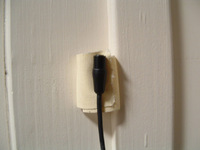Wind Noise
There are two types of wind noise: Contact and Acoustic. (Sound familiar? Did you pay attention to the article about Shockmounts & windscreens?)
Contact wind noise is the one we most frequently associate with microphones. That is the distortion caused when wind strikes the diaphragm of the mic itself.
The solution is to use a good windscreen. Which you will have to make yourself, because the flimsy little puffs of acoustic foam that come with most lavaliers are merely breath pop filters, not real windscreens!
The simplest tool for blocking wind is to salvage the foam booty that makes up the working end of a video head cleaning swab. After you service your video heads, save these sticks! Believe me, the micro dust collected from a video head will not affect sound quality on a windscreen.
Pull the foam tips off of the wooden sticks, and then slice them open at the base to form a foam cap. Slide the foam over your favorite lavalier, and instant windscreen. Since these screens are disposable, feel free to color them with markers for less visibility.
If rigging under clothing, feel free to sandwich them inside of your sticky triangles. So what if the tape destroys them!
A greater level of wind protection can be achieved by placing an oversize metal grill (such as from an ECM-55) over the foam.
Another trick is to wrap a thick layer of cheesecloth over the foam and the mic. For visible mics, snip the fingertips off of a pair of wool knit children’s winter gloves, and pull the wool "caps" over the cheesecloth. With a layer of wool, cheesecloth, and foam — you’re very well insulated from wind noise.
When hiding lavaliers inside heavy winter coats, a good technique is to bring the mic to the outside of the coat (to avoid excessive muffling) and to hide the mic under a patch of cloth or felt. These patches are readily obtained as "sample" swatches from any fabric store. Cut the swatches into a random pattern, so as not to be conspicuous. Rub some dirt over the patch to help blend it in.
The other type of wind noise is Acoustic. That is the sound of the wind howling through the trees or between the buildings. It is a form of background noise, like traffic noise, and cannot be eliminated by the use of a windscreen. Your best solution is to keep the mics close to talent. Rolling off the bass frequencies also helps a little, but wind howling is often all over the frequency spectrum.
Lavaliers as Plant Mics
The best solution to clothing noise is to keep the lavalier off of the body entirely.
Lavaliers are too stupid to know whether or not they are attached on the body, or just near one. It is a simple matter to hide lavaliers onto many handheld props, such as purses, clip boards, flash lights, cups, etc.
Remember to use a wad of sticky tape to "float" or shockmount the mic capsule so that it is not directly against a hard surface that might conduct vibration.
To rig a car, hide a lavalier on the inside of the sun visor. Any decent transparent lavalier will pickup driver, passenger, and probably backseat passenger. The visor is padded to reduce echo, and well away from the bottom of the car with related engine & road noise.
Transparent lavaliers also work well as hidden mics in the set. A mic in the centerpiece can give you a restaurant table. A mic in an executive pen set can pickup both sides of an across the desk encounter.
 A mic on the inside of a doorjam can give you that short line from a passerby poking his head into the office. (Click the thumbnail for the whole picture.)
A mic on the inside of a doorjam can give you that short line from a passerby poking his head into the office. (Click the thumbnail for the whole picture.)
Use your imagination! A telephone booth is a snap to rig. Someone reading directly off of a blackboard or bulletin board is perfect for a hidden lavalier. The headboard of a bed for those "marital relations" shots.
Perspective
A danger of using lavaliers is to forget to take perspective into account. A proximity lavalier always sounds like a tight close-up, even when the camera is fifty feet away.
Transparent mics sound much more natural, but unlike boom mics, their perspective is fixed. Booms move from farther to closer as the frame changes; lavaliers do not.
One quick fix to the perspective problem is to also deploy a shotgun mic directed at nothing in particular. The "bleed mic" is used to capture footsteps, ambiance, and general sound effects from an angle that will not pick up dialogue (two mics capturing the same sound will create phasing problems, echo, and tinniness). For long perspective, the bleed mic is mixed (say, 30%) with the dialogue from the lavalier. As the shot narrows to a close-up, the bleed mic is faded down, so that we are only left with the close-up sound of the lav.
Another trick to open up perspective when using lavaliers is to place them a little further down on the chest than normal. This creates a noisier track with more ambiance and less forced emphasis of voice.
Two actors playing opposite each other can be miked from each other’s lavalier, again opening up the soundtrack to appear more natural.
As you can see, there are a lot of ways to effectively utilize lavaliers.
